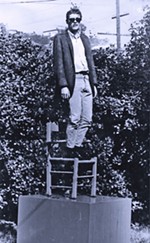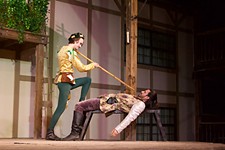Exibitionism
The Life of Galileo:body, Motion, Color
Fri., May 1, 1998
through May 2
Running Time: 3 hrs
Don't let the name fool you. The Life of Galileo may sound like a textbook snore, but it is The Public Domain's visually dazzling, engaging, and intriguing foray into the difficult and sometimes deadly truths of arts, science, and man.
Galileo — quick history lesson — was an Italian astronomer who eventually recanted his staunch support of the Copernican theory at the request of the Inquisition. Whatever consensus exists about Galileo's brilliance, his denial of what we know now as elementary still leaves at least one foot stuck in a moral quagmire. How could such an unearthly intellect fold to government intimidation? And how could Galileo live with himself afterward? Of course, only a few years prior, Italian philosopher and fellow Copernican Giordano Bruno was burned at the stake for such heresy. So one answer might be: Well, at least he lived. Bertolt Brecht's The Life of Galileo examines these complex questions, portraying the astronomer as a playful and hopelessly curious man blessed with a keen understanding of life's galactic truths.
Another historical quickie: Bertolt Brecht is a German dramatist who believed the audience should always remember those people onstage are a-c-t-i-n-g, and therefore employed ways to keep his actors aloof. Brecht would have despised the emotional juggernaut of Titanic, with its merciless pathos and swelling score. Such rebellious notions make Galileo and Brecht unlikely kindred spirits; and with this play, it is an anti-Aristotlean field day.
In The Life of Galileo, we witness Galileo evolve from fearless, egotistical philosopher unconcerned by the Plague to cynical man living deep in the shadow of his own denial of the truth. At every new episode (there are 14), Galileo is played by a different actor or sometimes actress. Such an ever-morphing character stands in stark contrast to the mathematical constants Galileo himself is espousing. And here we see the triumph of Brecht's work. While all his fancy penmanship perhaps sought to distance the audience intellectually, what he achieves even more beautifully is to add terrific layers of complexity to a man's actions and character, creating a Protean protagonist who must exist in the midst of precise, immutable truths, while the moral absolutes of man's universe keep sliding all over the place. Director Robi Polgar stages all this Big Top style, in a playful, vibrant space where Galileo is the master of ceremonies. Marc Silva's remarkable set design underscores the beauty in symmetry and precision upon which the talented ensemble romp, stomp, and unfold our story. While all the acting is solid, both Ehren Conner Christian and Martin Blacker stand out as players whose comic and dramatic flirtations spring each character to life. But the greatest accomplishment of The Public Domain's production is the sheer physicality of it. Polgar has choreographed a visual feast of body, motion, and color — the perfect visual contrast to the intellectual labyrinth of the text. To give examples of these physical feats would be to spoil much of the fun; suffice to say their dexterity and originality make the seemingly impossible crumble to dust. The play is long, and audiences should be warned that the constellation of stage lights peppering the ceiling can make for a toasty viewing. But The Public Domain proves itself creative, intelligent, and visually stunning — such stuff as stars are made of. — Sarah Hepola
THE PORTRAIT PROJECT:GUESTS AT DINNER
Movements Gallery,
April 18
What happens when the audience becomes part of the performance? It's a daunting thought and an edgy experience for an artist. Not only are you modulating your own performance, you're managing an unpredictable and uncertain audience. The Portrait Project, performed by Margery Segal/NERVE, produced a successful collaboration featuring the integration of movement, text, film, and installation art based on interviews with nine individuals. Staged in the intimate Movements Gallery above Sixth Street, the production invited the audience to follow the experience throughout the space with Segal as a guide.
Audience members ascended the staircase and were instructed to take a seat in one of the many antique wooden dining chairs placed throughout the room. Surrounded by displaced windows, disjointed bathroom fixtures, and a plastic-covered dining table and chairs, the atmosphere was at once homey and disquieting. Little did we know that we were sitting down to one of those hellaciously delicious experiences we all recognize: the inescapable dinner of exploding family dynamics and colliding egos. Segal deftly inhabited several of the characters we would visit throughout the evening, punctuating her lyrically contorted movement with both humorous and jarring verbal revelations. Unfortunately, some of the text was drowned out by loud music.
Segal abruptly exited the area, beckoning the audience to follow her into a world of colorfully fragmented puzzle pieces populated by unique personalities who related their life stories either on audiotape or through Segal's monologues. Segal successfully interwove key imagery and specific movement vocabularies from each interview segment to create a rich tapestry of personalities, a stretch for any performer. There were some hauntingly beautiful scenes: the stairwell bathed in dappled blue light, a sunburst mosaic of cutlery, fiery explosions flickering on torn green paper. Most of the transitions smoothly directed the audience toward the next segment, although some left nervous attendees wondering where to look or relocate next. It occurred to me later that much of the show depended on an aware and sensitive audience and, like it or not, we were performing in the piece as well.
Although other performers appeared, the show belonged to Segal. I have seen her perform several times and am continually moved by her deliberatlely multi-focused presence. It's as if she were seeing the world through brand-new eyes at every blink. The result is a sense of moment-by-moment exploration, a glimpse of the inner monologue we all carry on as we gather information, evaluate it, and act on it to respond to the outside world.
Segal guided the audience through the lives and experiences of nine unique individuals, unifying them with the common thread of home. Chairs and other furniture were ever present, perhaps as a reminder that although the stories may differ, these people have the same basic goals and desires as all of us. We, as guests, were invited to visit them in a familiar, if not always comforting, environment. — Dawn Davis
THE BROTHERS KARAMAZOV:MODERN TEETH
Theatre Room,
UT Winship Drama Bldg.
through May 2
Running Time: 2 hrs, 50 min
Three estranged brothers, one overbearing father — the Brothers Karamazov betray facets of the father they despise. Inevitably, the trio succumbs beneath the suffocating weight of their patriarch — the loathsome, devilish Fyodor — and their own shortcomings. Redemption, if it can be found in this bleak world, resides in acts of punishment. In this University of Texas Department of Theatre & Dance production of The Brothers Karamazov, the almost existential collapse of the family Karamazov exemplifies Dostoyevsky's modern understanding of man's vileness, and the retributive nature of conscience that trips a man hell-bent on his own destruction.
Alyosha, a novice, Ivan, an intellectual and atheist, and Dmitri, a soldier, meet for the first time at their father's behest. The headstrong Dmitri vows to destroy his promising relationship to wealthy fiancée Katya rather than exhibit any sign that he shares some of his father's financial cunning. From this initial meeting, the trio's courses are set. Dmitri's self-destruction initiates the descent, but all three must eventually confront their failings. Alyosha tests his faith and Ivan his lack thereof, neither wholly set free by the struggle. Around the brothers swirl confidantes and confederates, fatherly figures and sinister phonies. This is a base, capitalistic society wherein a man, or a woman, may own another as an investment — perhaps as a handful of promissory notes — to keep or sell as the fancy strikes.
Anthony Clarvoe's play, based on Dostoyevsky's novel, bares modern teeth. The language is sharp, and the play's depth and development are almost exquisite. With such authoritative and mature material, the company has a distinct advantage in telling such a potentially dreary, remote tale.
Alas, the young actors playing the three brothers haven't themselves the depth to fulfill the demands of such intricately crafted characters. Scot Hartman (Alyosha), Jessie Galvan (Ivan), and Kevin Alejandro (Dmitri) are engaging performers who give cavalier efforts, but something seems missing in voice, gesture, or an honest understanding of these complicated young men. The work of the supporting players, however, is quite strong. Guest artist Ev Lunning, Jr. provides a feast of a bastard with his portrayal of Fyodor, and makes an impish devil at play's end. In the role of unsung, Ur-brother Smerdyakov, Scott Phillips conveys a numbing bureaucratic tone, then reveals a duplicitous, wicked streak with particular sharpness. Melanie Myers' Grushenka projects alternately haughty, then derelict, sensuality, while maintaining an unusual empathy. Adam Howard Huneter makes Rakitin a first-class hypocrite and opportunist.
Faculty director Michael Bloom has conceived a stark world in which to entrap his all too-human characters. The austerity and crispness of Torsten Louis' sets and the bright interrogating frames of Jon Smith's lights in a sea of deep blues and dull browns reflect the existential doom of this 19th-century Russia. Bloom marks a simple, strong rhythm for the unwinding of this story, although a few, petty intrusions dilute an otherwise solid vision: a one-time-use microphone, actors in the audience, an irregular sound score, and bouts of melodrama that seem out of place in such a modern translation.
The production's strengths prevail, and there is a sense of hope at play's end: that the sins of the diabolic father revisited in the sons may be exorcised at last.
— Robi Polgar








